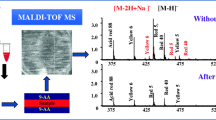Abstract
We have studied sample preparation conditions to increase the reproducibility of positive UV-MALDI-TOF mass spectrometry of peptides in the amol range. By evaluating several α-cyano-4-hydroxy-cinnamic acid (CHCA) matrix batches and preparation protocols, it became apparent that two factors have a large influence on the reproducibility and the quality of the generated peptide mass spectra: (1) the selection of the CHCA matrix, which allows the most sensitive measurements and an easier finding of the “sweet spots,” and (2) the amount of the sample volume deposited onto the thin crystalline matrix layer. We have studied in detail the influence of a contaminant, coming from commercial CHCA matrix batches, on sensitivity of generated peptide mass spectra in the amol as well as fmol range of a tryptic peptide mixture. The structure of the contaminant, N,N-dimethylbutyl amine, was determined by applying MALDI-FT-ICR mass spectrometry experiments for elemental composition and MALDI high energy CID experiments utilizing a tandem mass spectrometer (TOF/RTOF). A recrystallization of heavily contaminated CHCA batches that reduces or eliminates the determined impurity is described. Furthermore, a fast and reliable method for the assessment of CHCA matrix batches prior to tryptic peptide MALDI mass spectrometric analyses is presented.

ᅟ





Similar content being viewed by others
References
Karas, M., Bachmann, D., Bahr, U., Hillenkamp, F.: Matrix-assisted ultraviolet laser desorption of non-volatile compounds. Int. J. Mass Spectrom. 78, 53–56 (1987)
Tanaka, K., Waki, H., Ido, Y., Akita, S., Yoshida, Y.: Protein and polymer analysis up to m/z 100,000 by laser ionization time-of-flight mass spectrometry. Rapid Commun. Mass Spectrom. 2, 151–153 (1988)
Vestal, M.J., Juhasz, P., Martin, S.A.: Delayed extraction matrix-assisted laser desorption time-of flight mass spectrometry. Rapid Commun. Mass Spectrom. 9, 1044–1050 (1995)
Kaufmann, R., Chaurand, P., Kirsch, D., Spengler, B.: Post-source decay and delayed extraction in matrix-assisted laser desorption/ionization-reflectron time-of-flight mass spectrometry. Rapid Commun. Mass Spectrom. 10, 1199–1208 (1996)
Kussmann, M., Nordhoff, E., Rahbek-Nielsen, H., Haebel, S., Rossel-Larsen, M., Jakobsen, L., Gobom, J., Mirgorodskaya, E., Kroll-Kirstensen, A., Palm, L., Roepstorff, P.: Matrix-assisted laser desorption/ionization mass spectrometry sample preparation techniques designed for various peptide and protein analytes. J. Mass Spectrom. 32, 593–601 (1997)
Landry, F., Lombardo, C.H., Smith, J.W.: A method for application of samples to matrix-assisted laser desorption ionization time-of-flight targets that enhances peptide detection. Anal. Biochem. 279, 1–8 (2000)
Keller, B.O., Li, L.: Detection of 2500 molecules of substance P by MALDI TOF mass spectrometry and investigations into the fundamental limits of detection in MALDI. J. Am. Soc. Mass Spectrom. 12, 1055–1063 (2001)
Vorm, O., Roepstorff, P., Mann, M.: Improved resolution and very high sensitivity in MALDI time-of-flight surfaces made by fast evaporation. Anal. Chem. 66, 3281–3287 (1994)
Lake, D.A., Johnson, M.V., McEwen, C.N., Larsen, B.S.: Sample preparation for high throughput accurate mass analysis by matrix-assisted laser desorption/ionization time-of-flight mass spectrometry. Rapid Commun. Mass Spectrom. 14, 1008–1013 (2000)
Beavis, R.C., Chaudhary, T., Chait, B.T.: α-Cyano-4-hydroxy cinnamic acid as a matrix for matrix-assisted laser desorption mass spectrometry. Org. Mass Spectrom. 27, 156–158 (1992)
Gobom, J., Schuerenberg, M., Mueller, M., Theiss, D., Lehrach, H., Nordhoff, E.: α-Cyano-4-hydroxycinnamic acid affinity sample preparation. A protocol for MALDI MS peptide analysis in proteomics. Anal. Chem. 73, 434–438 (2001)
Vestal, M., Juhasz, P., Hines, W., Martin, S.: A new delayed extraction MALDI-TOF MS-MS for characterization of protein digests. In: Burlingame, A.L., Carr, S.A., Baldwin, M.A. (eds.) Mass spectrometry in biology and medicine, pp. 1–16. Humana Press, New York (1999)
Schaub, T.M., Hendrickson, C.L., Quinn, J.P., Rodgers, R.P., Marshall, A.G.: Instrumentation and method for ultrahigh resolution field desorption ionization Fourier transform ion cyclotron resonance mass spectrometry of nonpolar species. Anal. Chem. 77, 1317–1324 (2005)
Senko, M.W., Canterbury, J.D., Guan, S., Marshall, A.G.: A high-performance modular data system for Fourier transform ion cyclotron resonance mass spectrometry. Rapid Commun. Mass Spectrom. 10, 1839–1844 (1996)
Blakney, G.T., Hendrickson, C.L., Marshall, A.G.: Predator data station: A fast data acquisition system for advanced FT-ICR MS experiments. Int. J. Mass Spectrom. 306, 246–252 (2011)
Marshall, A.G., Roe, D.C.: Theory of Fourier transform ion cyclotron mass spectrometry: response to frequency-sweep excitation. J. Chem. Phys. 73, 1581–1590 (1980)
Li, L., Golding, R.E., Whittal, R.M.: Detection of 25,000 molecules of Substance P by MALDI-TOF mass spectrometry and investigations into the fundamental limits of the detection. J. Am. Chem. Soc. 188, 11662–11663 (2001)
Zhang, H., Andren, P.E., Caprioli, R.M.: Micro-preparation procedure for high-sensitivity matrix-assisted laser desorption ionization mass spectrometry. J. Mass Spectrom. 30, 1768–1771 (1995)
Acknowledgments
The authors acknowledge support for this work by the Austrian Science Foundation (grant 14181 to G.A.), and support in part by the National Science Foundation (CHE-99-09502), Florida State University, Ohio State University, and the National High Magnetic Field Laboratory in Tallahassee, FL, USA. The authors appreciate the instrumental support of Alan G. Marshall and Christopher L. Hendrickson (both Tallahassee, FL, USA). In the meantime high-quality CHCA matrix batches can purchased from some vendors. Furthermore, the authors thank K. Jackson (Manchester, UK) and M. Karas (Frankfurt/Main, Germany) for the helpful discussions during the characterization of the CHCA contaminant.
Author information
Authors and Affiliations
Corresponding author
Additional information
This paper is dedicated to our colleague Professor Bob Cotter in recognition of the 2011 ASMS Award for Distinguished Contribution to Mass Spectrometry
Electronic supplementary material
Below is the link to the electronic supplementary material.
ESM 1
(PPT 307 kb)
Rights and permissions
About this article
Cite this article
Rechthaler, J., Pittenauer, E., Schaub, T.M. et al. Detection of Amine Impurity and Quality Assessment of the MALDI Matrix α-Cyano-4-Hydroxy-Cinnamic Acid for Peptide Analysis in the amol Range. J. Am. Soc. Mass Spectrom. 24, 701–710 (2013). https://doi.org/10.1007/s13361-013-0614-0
Received:
Revised:
Accepted:
Published:
Issue Date:
DOI: https://doi.org/10.1007/s13361-013-0614-0




